#New York Collage Ensemble
Explore tagged Tumblr posts
Photo


THIS WEEK AT KOLAJ MAGAZINE
Remnants, Fabrications, & Getting Good
KOLAJ 31 Lost & Found: Collages Stolen from UNCTAD III during the 1973 Military Coup in Chile by Marco Antonio Núñez
COLLAGE COMMUNITIES New York Collage Ensemble
FROM KOLAJ 31 Getting Good: Potential of Collage as a Tool for Wellbeing by Hazel Pitt
COLLAGE ON VIEW Fabrications at Drill Hall Gallery at the Australian National University in Acton, ACT
FROM THE ARTIST DIRECTORY Uneasy Projections: Alex Kuhse; San Diego, California, USA.
COLLAGE ON VIEW Remnants at the Wisconsin Museum of Quilts and Fiber Arts in Cedarburg, Wisconsin
FROM THE ARTIST DIRECTORY More Wistfulness: Jennie Mejan; Winston Salem, North Carolina, USA.
Read the full update
*****************************
Kolaj Magazine, a full color, print magazine, exists to show how the world of collage is rich, layered, and thick with complexity. By remixing history and culture, collage artists forge new thinking. To understand collage is to reshape one’s thinking of art history and redefine the canon of visual culture that informs the present.
SUBSCRIBE | CURRENT ISSUE | GET A COPY
SIGN UP TO GET EMAILS
#KOLAJ#KOLAJ MAGAZINE#Remnants#Fabrications#Getting Good#KOLAJ 31#Lost & Found#UNCTAD III#1973#Military Coup#Chile#Marco Antonio Núñez#New York Collage Ensemble#Potential of Collage as a Tool for Wellbeing#Hazel Pitt#Drill Hall Gallery#Australian National University#Acton#ACT#Uneasy Projections#Alex Kuhse#San Diego#California#USA#Wisconsin Museum of Quilts and Fiber Arts#Cedarburg#Wisconsin#Jennie Mejan#Winston Salem#North Carolina
12 notes
·
View notes
Text
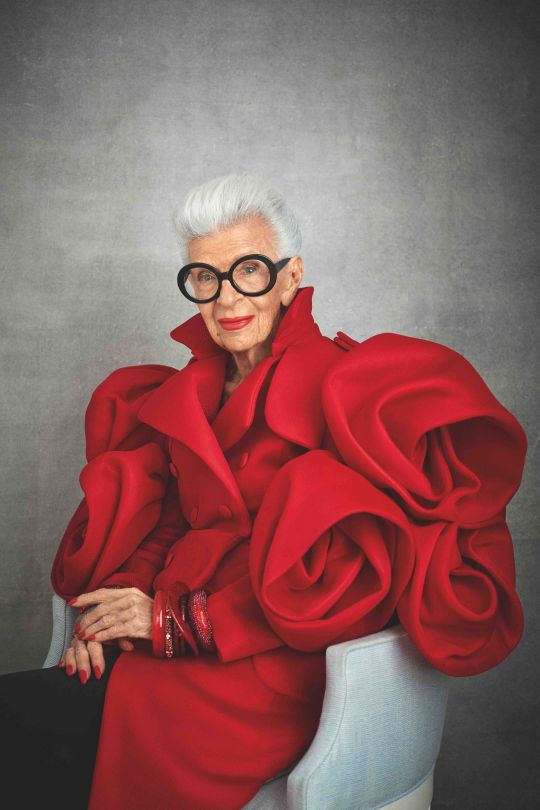
Iris Apfel was finally recognised as a great, original fashion stylist in her 80s, when the Costume Institute at the Metropolitan Museum in New York had a sudden gap in its 2005 exhibition schedule. Many curators knew Apfel, who has died aged 102, as a collector stashing away clothes, especially costume jewellery, both couture-high and street-market-low, so the institute asked to borrow some of her thousands of pieces.
When Apfel wore them herself, dozens at a time in ensembles collaged fresh daily, they had zingy pzazz, so she was invited to set up the displays. There was no publicity budget, and her name was modestly known only in the interior decor trade, yet the show, Rara Avis: Selections from the Iris Apfel Collection, became a huge success after visitors promoted it online. It toured other American museums, changing exhibits en route because Apfel wanted her stuff back so she could wear it.
Apfel’s grandfather had been a master tailor in Russia; her father, Samuel Barrel, supplied mirrors to smart decorators; her chic mother, Sadye (nee Asofsky), had a fashion shop. They lived out in rural Astoria, in the Queens borough of New York, where Iris was born.
As a child, her treat was a weekly subway trip to Manhattan to explore its shops, her favourites the junk emporia of Greenwich Village. She was short, plain and, until her teen years, plump, but she had style; and the owner of a Brooklyn department store picked her out of a crowd to tell her so. During the Depression all her family could sew, drape, glue, paint and otherwise create the look of a room, or a person, on a budget of cents – the best of educations.
She studied art history at New York University, then qualified to teach and did so briefly in Wisconsin before fleeing back to New York to work on Women’s Wear Daily. Furniture and fabrics were in short supply during and after the second world war, and Iris began to earn by sourcing antiques and textiles; if she could not find it, she could make or fake it cheaply.
In 1948 she married Carl Apfel, and they became a decorating team: he had the head for business and she the eye. Unable to find cloth appropriate to a period decor, Iris adapted a design from an old piece and had it woven in a friend’s family mill; she and Carl then set up Old World Weavers in 1952, commissioning traditional makers around the globe.
Photographs and home-movie footage from the next four decades showed Apfel, adorned with elan, haggling for one-off items in souks, flea markets and bric-a-brac shops. She is the most decorative sight in each shot, her ensembles put together with complex cadenzas atop an underlying, tailored, structure– they are like jazz – not a statement, but a conversation.
Apfel was the last of those 20th-century fashion exotics who presented themselves as installations. Although she wore a priest’s warm tunic to the White House (President Richard Nixon underheated the place), plus armfuls of cheap African bracelets and thigh-high boots, she was not an exhibitionist like the Marchesa Casati, and, with her vaudevillian comic timing, was far funnier than the imperious Vogue editor Diana Vreeland.
Also, she never ever bought full-price: her many rails and under-the-bed suitcases of couture were sale-price samples, chosen for their cut, fabric, skilled craftwork and colour dazzle (“Colour can raise the dead”). She might wear them over thrift shop pyjamas, or under a Peking Opera costume, with hawsers of necklaces atop. Money could not buy personal style, she said, prettiness withered, beauty could corrode the soul. All that really mattered was “attitude, attitude, attitude”.
Old World Weavers discreetly refurbished the White House under nine presidents, as well as grand hotels and private houses, before the Apfels sold the company in 1992. They retired to a quiet life in their apartment on Park Avenue, New York, its decor an extension of Apfel’s outfits (bad garment choices were cut up for cushions), and in a Palm Beach holiday home where the Christmas decoration collection stayed up all year round, along with cuddly toys and museum-class folk art. Clothes shopping, and the improvisation of an outfit, became Apfel’s daily ritual, as cooking might be to a gourmet.
But after the Met show, and a book, Rare Bird of Fashion (2007), Apfel was back in as much full-time employment as she could manage in her 80s and 90s (she had a hip replacement because she fell after stepping on an Oscar de la Renta gown). She was cover girl of Dazed and Confused, among many other publications, window display artist at Bergdorf Goodman, designer and design consultant – superb on eye-glasses; she wore large, owl-like, frames to stylise her aged face into a witty, unchanging, cartoon.
She took seriously her responsibilities to fashion students on her course at the University of Texas, teaching them about imagination, craft and tangible pleasures in a world of images.
Her career lasted – nothing was ever too late: in 2018, Iris Apfel: Accidental Icon, a book of memoir and sound style advice; in 2019, a contract with the model agency IMG; and last year, a beauty campaign for makeup with Ciaté London. The documentarian Albert Maysles trailed her for Iris (2014), filming this “geriatric starlet” – her term – as she dealt drolly with new high-fashion friends, or laughed at an “Iris” Halloween costume (glasses, a ton of bangles).
She watched as a storage loft of her antique treasures was listed in lots for sale, and as white-gloved assistants from museums that had begged a bequest boxed up her garments; she still had, and wore, the shoes from her wedding. All things, she said, were only on loan in this world, even to collectors. The point was to enjoy them to the full before bidding them good-bye.
Carl died in 2015.
🔔 Iris Barrel Apfel, decorator and fashion stylist, born 29 August 1921; died 1 March 2024
Daily inspiration. Discover more photos at Just for Books…?
30 notes
·
View notes
Text

Graphic collage made for the cover of A Little Treatise On Morals
Donald Miller
Audiofile Tapes
New York City, NY
1987
This collage was created for Donald Miller's debut solo album, released on Carl Howard's New York-based industrial/experimental/electronic label, Audiofile Tapes. Before and after the release of A Little Treatise on Morals, Don had extensive experience playing in various bands such as Borbetomagus, Lhasa Cement Plant, Sick Dick and the Volkswagens, The Donald Miller Trio, and The William Hooker Group and Ensemble. This would be his only solo effort for twenty years.
The project consists of three standalone tracks and one megamix of three movements or 'substratas,' all recorded in late May 1982 when Miller was finishing his Bachelor of Fine Arts degree from Columbia University's College and the School of Visual Arts. Each piece is dedicated to another artist: Hans Bellmer, Austin Osman Spare, Lee Teich, Brian Doherty, Kembra Pfahler, and Marc Slivka.
0 notes
Photo

We're pleased to invite Members to reserve their complimentary tickets to The Obama Portraits Tour, Christian Dior: Designer of Dreams, and Andy Warhol: Revelation. Act fast, because this exclusive Member pre-sale ends June 16!
We’ve launched a new online ticketing platform, offering a more streamlined and seamless ticketing and Membership experience! You’ll need to activate your Membership account by resetting your password using an easy, one-time process. You'll then receive an email from Ticketure confirming your account. The process only takes a few minutes, after which you’ll be able to immediately reserve your tickets.
Kehinde Wiley (American, born 1977). Barack Obama, 2018. Oil on canvas. National Portrait Gallery, Smithsonian Institution. © 2018 Kehinde Wiley; Amy Sherald (American, born 1973). Michelle LaVaugn Robinson Obama, 2018. Oil on linen. National Portrait Gallery, Smithsonian Institution. The National Portrait Gallery is grateful to the generous donors who made these commissions of the Obama Portraits possible and proudly recognizes them at npg.si.edu/obamaportraitstour. Support for the national tour has been generously provided by Bank of America; Christian Dior (French, 1905–1957). Bar suit, afternoon ensemble with an ecru natural shantung jacket and black pleated wool crepe skirt. Haute Couture Spring–Summer 1947, Corolle line. Dior Héritage collection, Paris. (Composite scan: Katerina Jebb); Andy Warhol (American, 1928–1987). The Last Supper (Detail), 1986. Screenprint and colored graphic art paper collage on HMP paper. The Andy Warhol Museum, Pittsburgh; Founding Collection, Contribution The Andy Warhol Foundation for the Visual Arts, Inc., 1998.1.2125. © 2021 The Andy Warhol Foundation for the Visual Arts, Inc. / Licensed by Artists Rights Society (ARS), New York. Used with permission of Warhol Foundation
#ObamaPortraitsTour#diordesignerofdreams#warholrevelation#barack obama#michelle obama#obama#christian dior#dior#andy warhol#warhol#brooklyn museum#brooklyn#warholfoundation
69 notes
·
View notes
Text



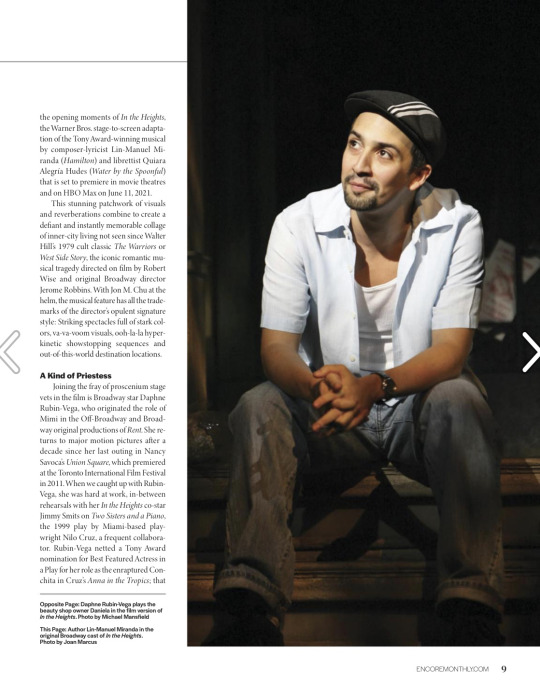
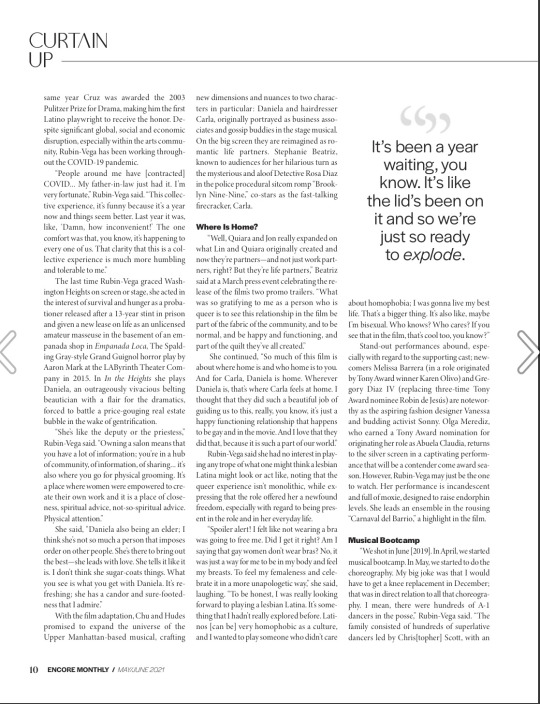
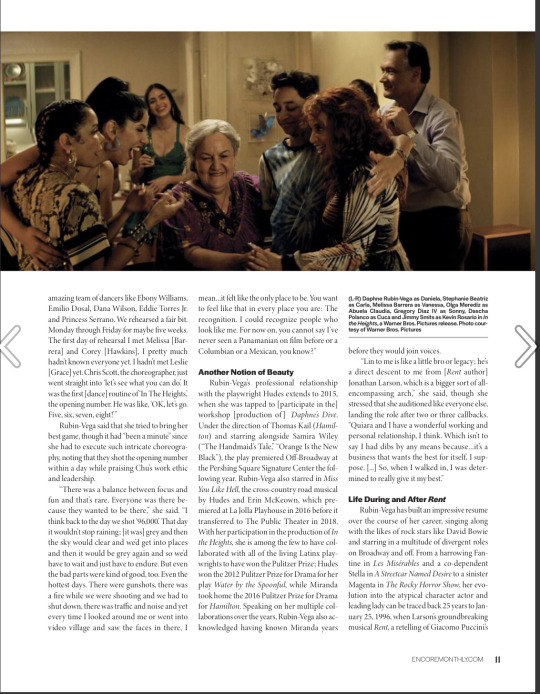

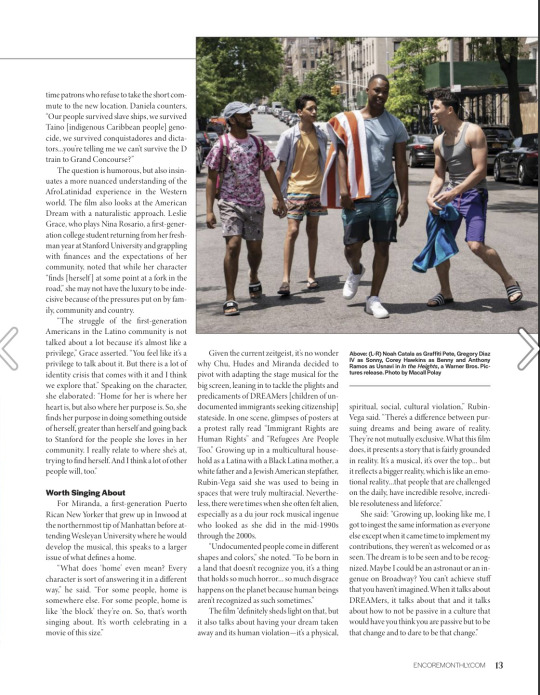

HITTING NEW HEIGHTS
BY MARCUS SCOTT
ORIGINAL RENT STAR DAPHNE RUBIN-VEGA TAKES YOU INSIDE THE IN THE HEIGHTS FILM
Qué quiere decir sueñito?” The disembodied voice of a girlchild ponders. “It means ‘little dream,’” responds an unseen authoritative figure, his feathery tenor with a soft rasp and tender lilt implying there’s more to the story.
Teal waves crash against the white sand coastal lines of the Dominican Republic and a quartet of children plead with the voice to illuminate and tell a story. Usnavi de la Vega (played by Anthony Ramos), sporting his signature newsboy flat cap and full goatee, begins to narrate and weave a tall-tale from the comforts of his beachside food cart: “This is the story of a block that was disappearing. Once upon a time in a faraway land called Nueva York, en barrio called Washington Heights. Say it, so it doesn’t disappear,” he decrees.
And we’re off, this distant magic kingdom ensnared within the winding urban sprawl of farthest-uptown Manhattan, the music of the neighborhood chiming with infinite possibilities: a door-latch fastening on tempo, a ring of keys sprinkling a sweet embellishment, the splish-splash of a garden hose licking the city streets like a drumstick to a snare fill, a manhole cover rotating like vinyl on a get-down turntable, the hiss of paint cans spraying graffiti like venoms from cobras and roll-up steel doors rumbling, not unlike the ultra-fast subway cars zigzagging underground. So begins the opening moments of In the Heights, the Warner Bros. stage-to-screen adaptation of the Tony Award-winning musical by composer-lyricist Lin-Manuel Miranda (Hamilton) and librettist Quiara Alegría Hudes (Water by the Spoonful) that is set to premiere in movie theatres and on HBO Max on June 11, 2021.
This stunning patchwork of visuals and reverberations combine to create a defiant and instantly memorable collage of inner-city living not seen since Walter Hill’s 1979 cult classic The Warriors or West Side Story, the iconic romantic musical tragedy directed on film by Robert Wise and original Broadway director Jerome Robbins. With Jon M. Chu at the helm, the musical feature has all the trademarks of the director’s opulent signature style: Striking spectacles full of stark colors, va-va-voom visuals, ooh-la-la hyperkinetic showstopping sequences and out-of-this-world destination locations.
WANT TO SEE MORE STORIES LIKE THIS?
SUBSCRIBE NOW
A Kind of Priestess
Joining the fray of proscenium stage vets in the film is Broadway star Daphne Rubin-Vega, who originated the role of Mimi in the Off-Broadway and Broadway original productions of Rent. She returns to major motion pictures after a decade since her last outing in Nancy Savoca’s Union Square, which premiered at the Toronto International Film Festival in 2011. When we caught up with Rubin-Vega, she was hard at work, in-between rehearsals with her In the Heights co-star Jimmy Smits on Two Sisters and a Piano, the 1999 play by Miami-based playwright Nilo Cruz, a frequent collaborator. Rubin-Vega netted a Tony Award nomination for Best Featured Actress in a Play for her role as the enraptured Conchita in Cruz’s Anna in the Tropics; that same year Cruz was awarded the 2003 Pulitzer Prize for Drama, making him the first Latino playwright to receive the honor. Despite significant global, social and economic disruption, especially within the arts community, Rubin-Vega has been working throughout the COVID-19 pandemic.
“People around me have [contracted] COVID… My father-in-law just had it. I’m very fortunate,” Rubin-Vega said. “This collective experience, it’s funny because it’s a year now and things seem better. Last year it was, like, ‘Damn, how inconvenient!’ The one comfort was that, you know, it’s happening to every one of us. That clarity that this is a collective experience is much more humbling and tolerable to me.”
The last time Rubin-Vega graced Washington Heights on screen or stage, she acted in the interest of survival and hunger as a probationer released after a 13-year stint in prison and given a new lease on life as an unlicensed amateur masseuse in the basement of an empanada shop in Empanada Loca, The Spalding Gray-style Grand Guignol horror play by Aaron Mark at the LAByrinth Theater Company in 2015. In In the Heights she plays Daniela, an outrageously vivacious belting beautician with a flair for the dramatics, forced to battle a price-gouging real estate bubble in the wake of gentrification.
“She’s like the deputy or the priestess,” Rubin-Vega said. “Owning a salon means that you have a lot of information; you’re in a hub of community, of information, of sharing… it’s also where you go for physical grooming. It’s a place where women were empowered to create their own work and it is a place of closeness, spiritual advice, not-so-spiritual advice. Physical attention.”
She said, “Daniela also being an elder; I think she’s not so much a person that imposes order on other people. She’s there to bring out the best—she leads with love. She tells it like it is. I don’t think she sugar-coats things. What you see is what you get with Daniela. It’s refreshing; she has a candor and sure-footedness that I admire.”
With the film adaptation, Chu and Hudes promised to expand the universe of the Upper Manhattan-based musical, crafting new dimensions and nuances to two characters in particular: Daniela and hairdresser Carla, originally portrayed as business associates and gossip buddies in the stage musical. On the big screen they are reimagined as romantic life partners. Stephanie Beatriz, known to audiences for her hilarious turn as the mysterious and aloof Detective Rosa Diaz in the police procedural sitcom romp “Brooklyn Nine-Nine,” co-stars as the fast-talking firecracker, Carla.
It’s been a year waiting, you know. It’s like the lid’s been on it and so we’re just so ready to explode.
Where Is Home?
“Well, Quiara and Jon really expanded on what Lin and Quiara originally created and now they’re partners—and not just work partners, right? But they’re life partners,” Beatriz said at a March press event celebrating the release of the film’s two promo trailers. “What was so gratifying to me as a person who is queer is to see this relationship in the film be part of the fabric of the community, and to be normal, and be happy and functioning, and part of the quilt they’ve all created.”
She continued, “So much of this film is about where home is and who home is to you. And for Carla, Daniela is home. Wherever Daniela is, that’s where Carla feels at home. I thought that they did such a beautiful job of guiding us to this, really, you know, it’s just a happy functioning relationship that happens to be gay and in the movie. And I love that they did that, because it is such a part of our world.”
Rubin-Vega said she had no interest in playing any trope of what one might think a lesbian Latina might look or act like, noting that the queer experience isn’t monolithic, while expressing that the role offered her a newfound freedom, especially with regard to being present in the role and in her everyday life.
“Spoiler alert! I felt like not wearing a bra was going to free me. Did I get it right? Am I saying that gay women don’t wear bras? No, it was just a way for me to be in my body and feel my breasts. To feel my femaleness and celebrate it in a more unapologetic way,” she said, laughing. “To be honest, I was really looking forward to playing a lesbian Latina. It’s something that I hadn’t really explored before. Latinos [can be] very homophobic as a culture, and I wanted to play someone who didn’t care about homophobia; I was gonna live my best life. That’s a bigger thing. It’s also like, maybe I’m bisexual. Who knows? Who cares? If you see that in the film, that’s cool too, you know?”
Stand-out performances abound, especially with regard to the supporting cast; newcomers Melissa Barrera (in a role originated by Tony Award winner Karen Olivo) and Gregory Diaz IV (replacing three-time Tony Award nominee Robin de Jesús) are noteworthy as the aspiring fashion designer Vanessa and budding activist Sonny. Olga Merediz, who earned a Tony Award nomination for originating her role as Abuela Claudia, returns to the silver screen in a captivating performance that will be a contender come award season. However, Rubin-Vega may just be the one to watch. Her performance is incandescent and full of moxie, designed to raise endorphin levels. She leads an ensemble in the rousing “Carnaval del Barrio,” a highlight in the film.
Musical Bootcamp
“We shot in June [2019]. In April, we started musical bootcamp. In May, we started to do the choreography. My big joke was that I would have to get a knee replacement in December; that was in direct relation to all that choreography. I mean, there were hundreds of A-1 dancers in the posse,” Rubin-Vega said. “The family consisted of hundreds of superlative dancers led by Chris[topher] Scott, with an amazing team of dancers like Ebony Williams, Emilio Dosal, Dana Wilson, Eddie Torres Jr. and Princess Serrano. We rehearsed a fair bit. Monday through Friday for maybe five weeks. The first day of rehearsal I met Melissa [Barrera] and Corey [Hawkins], I pretty much hadn’t known everyone yet. I hadn’t met Leslie [Grace] yet. Chris Scott, the choreographer, just went straight into ‘let’s see what you can do.’ It was the first [dance] routine of ‘In The Heights,’ the opening number. He was like, ‘OK, let’s go. Five, six, seven, eight!’”
Rubin-Vega said that she tried to bring her best game, though it had “been a minute” since she had to execute such intricate choreography, noting that they shot the opening number within a day while praising Chu’s work ethic and leadership.
“There was a balance between focus and fun and that’s rare. Everyone was there because they wanted to be there,” she said. “I think back to the day we shot ‘96,000.’ That day it wouldn’t stop raining; [it was] grey and then the sky would clear and we’d get into places and then it would be grey again and so we’d have to wait and just have to endure. But even the bad parts were kind of good, too. Even the hottest days. There were gunshots, there was a fire while we were shooting and we had to shut down, there was traffic and noise and yet every time I looked around me or went into video village and saw the faces in there, I mean…it felt like the only place to be. You want to feel like that in every place you are: The recognition. I could recognize people who look like me. For now on, you cannot say I’ve never seen a Panamanian on film before or a Columbian or a Mexican, you know?”
Another Notion of Beauty
Rubin-Vega’s professional relationship with the playwright Hudes extends to 2015, when she was tapped to [participate in the] workshop [production of] Daphne’s Dive. Under the direction of Thomas Kail (Hamilton) and starring alongside Samira Wiley (“The Handmaid’s Tale,” “Orange Is the New Black”), the play premiered Off-Broadway at the Pershing Square Signature Center the following year. Rubin-Vega also starred in Miss You Like Hell, the cross-country road musical by Hudes and Erin McKeown, which premiered at La Jolla Playhouse in 2016 before it transferred to The Public Theater in 2018. With her participation in the production of In the Heights, she is among the few to have collaborated with all of the living Latinx playwrights to have won the Pulitzer Prize; Hudes won the 2012 Pulitzer Prize for Drama for her play Water by the Spoonful, while Miranda took home the 2016 Pulitzer Prize for Drama for Hamilton. Speaking on her multiple collaborations over the years, Rubin-Vega also acknowledged having known Miranda years before they would join voices.
“Lin to me is like a little bro or legacy; he’s a direct descent to me from [Rent author] Jonathan Larson, which is a bigger sort of all-encompassing arch,” she said, though she stressed that she auditioned like everyone else, landing the role after two or three callbacks. “Quiara and I have a wonderful working and personal relationship, I think. Which isn’t to say I had dibs by any means because…it’s a business that wants the best for itself, I suppose. […] So, when I walked in, I was determined to really give it my best.”
Life During and After Rent
Rubin-Vega has built an impressive resume over the course of her career, singing along with the likes of rock stars like David Bowie and starring in a multitude of divergent roles on Broadway and off. From a harrowing Fantine in Les Misérables and a co-dependent Stella in A Streetcar Named Desire to a sinister Magenta in The Rocky Horror Show, her evolution into the atypical character actor and leading lady can be traced back 25 years to January 25, 1996, when Larson’s groundbreaking musical Rent, a retelling of Giacomo Puccini’s 19th-century opera La Bohème, premiered at the New York Theatre Workshop. On the morning of the first preview, Larson suffered an aortic dissection, likely from undiagnosed Marfan’s syndrome and died at the age of 35, just ten days shy of what would have been his 36th birthday.
On April 29, 1996, due to overwhelming popularity, Rent transferred to Nederlander Theatre on Broadway, tackling contemporary topics the Great White Way had rarely seen, such as poverty and class warfare during the AIDS epidemic in New York City’s gritty East Village at the turn of the millennium. Rubin-Vega would go on to be nominated for the Tony Award for Best Performance by a Leading Actress in a Musical for her role as sex kitten Mimi Márquez, an HIV-positive heroin addict and erotic dancer.
The show became a cultural phenomenon, receiving several awards including the Pulitzer Prize for Drama and four Tony Awards, including Best Musical. Rubin-Vega and members of the original Broadway cast were suddenly overnight sensations, recording “Seasons of Love” alongside music icon Stevie Wonder, receiving a photo shoot with Vanity Fair and landing the May 13, 1996 cover of Newsweek. Throughout its 12-year Broadway run, many of the show’s original cast members and subsequent replacements would go on to be stars, including Renée Elise Goldsberry, who followed in Rubin-Vega’s footsteps to play the popular character before originating the role of Angelica Schuyler in Hamilton, for which she won the 2016 Tony Award for Best Featured Actress in a Musical.
When the screen adaptation of Rent hit cinemas in 2005 under the direction of Chris Columbus, Rubin-Vega’s conspicuous absence came as a blow to longtime fans. The confluence of pregnancy with the casting and filming process of Rent hindered her from participating at the time. The role was subsequently given to movie star Rosario Dawson.
“First of all, if you’re meant to be in a film, you’re meant to be in it,” Rubin-Vega said. “That’s just the way it goes. It took a quarter of a century but this [In the Heights] is a film that I wanted to make, that I felt the elements sat right. I always felt that Rent was a little bit darker than all that. Rent to me is Rated R. In The Heights is not. It’s also a testament. Unless it’s sucking your soul and killing you softly or hardly, just stick with it. This is a business and I keep forgetting it’s a business because actors just want to show art. So, it’s really wonderful when you get a chance to say what you mean and mean what you say with your work. It’s a really wonderful gift.”
Rarely-Explored Themes
Like Larson’s award-winning show and the film adapted from it, In The Heights is jam-packed with hard-hitting subject matter, addressing themes of urban blight, immigration, gentrification, cultural identity, assimilation and U.S. political history. When Rubin-Vega’s character Daniela and her partner were priced out of the rent for her salon, most of her clientele moved to the Grand Concourse Historic District in the Bronx. Her salon, a bastion of the community, is met with a polar response when she announces she’s joining the mass exodus with the other victims of gentrification who were pushed out by rising rents. The news is met with negative response from long-time patrons who refuse to take the short commute to the new location. Daniela counters, “Our people survived slave ships, we survived Taino [indigenous Caribbean people] genocide, we survived conquistadores and dictators…you’re telling me we can’t survive the D train to Grand Concourse?”
The question is humorous, but also insinuates a more nuanced understanding of the AfroLatinidad experience in the Western world. The film also looks at the American Dream with a naturalistic approach. Leslie Grace, who plays Nina Rosario, a first-generation college student returning from her freshman year at Stanford University and grappling with finances and the expectations of her community, noted that while her character “finds [herself] at some point at a fork in the road,” she may not have the luxury to be indecisive because of the pressures put on by family, community and country.
“The struggle of the first-generation Americans in the Latino community is not talked about a lot because it’s almost like a privilege,” Grace asserted. “You feel like it’s a privilege to talk about it. But there is a lot of identity crisis that comes with it and I think we explore that.” Speaking on the character, she elaborated: “Home for her is where her heart is, but also where her purpose is. So, she finds her purpose in doing something outside of herself, greater than herself and going back to Stanford for the people she loves in her community. I really relate to where she’s at, trying to find herself. And I think a lot of other people will, too.”
Worth Singing About
For Miranda, a first-generation Puerto Rican New Yorker that grew up in Inwood at the northernmost tip of Manhattan before attending Wesleyan University where he would develop the musical, this speaks to a larger issue of what defines a home.
“What does ‘home’ even mean? Every character is sort of answering it in a different way,” he said. “For some people, home is somewhere else. For some people, home is like ‘the block’ they’re on. So, that’s worth singing about. It’s worth celebrating in a movie of this size.”
Given the current zeitgeist, it’s no wonder why Chu, Hudes and Miranda decided to pivot with adapting the stage musical for the big screen, leaning in to tackle the plights and predicaments of DREAMers [children of undocumented immigrants seeking citizenship] stateside. In one scene, glimpses of posters at a protest rally read “Immigrant Rights are Human Rights” and “Refugees Are People Too.” Growing up in a multicultural household as a Latina with a Black Latina mother, a white father and a Jewish American stepfather, Rubin-Vega said she was used to being in spaces that were truly multiracial. Nevertheless, there were times when she often felt alien, especially as a du jour rock musical ingenue who looked as she did in the mid-1990s through the 2000s.
“Undocumented people come in different shapes and colors,” she noted. “To be born in a land that doesn’t recognize you, it’s a thing that holds so much horror… so much disgrace happens on the planet because human beings aren’t recognized as such sometimes.”
The film “definitely sheds light on that, but it also talks about having your dream taken away and its human violation—it’s a physical, spiritual, social, cultural violation,” Rubin-Vega said. “There’s a difference between pursuing dreams and being aware of reality. They’re not mutually exclusive. What this film does, it presents a story that is fairly grounded in reality. It’s a musical, it’s over the top… but it reflects a bigger reality, which is like an emotional reality…that people that are challenged on the daily, have incredible resolve, incredible resoluteness and lifeforce.”
She said: “Growing up, looking like me, I got to ingest the same information as everyone else except when it came time to implement my contributions, they weren’t as welcomed or as seen. The dream is to be seen and to be recognized. Maybe I could be an astronaut or an ingenue on Broadway? You can’t achieve stuff that you haven’t imagined. When it talks about DREAMers, it talks about that and it talks about how to not be passive in a culture that would have you think you are passive but to be that change and to dare to be that change.”
Dreams Come True
Dreams are coming true. Alongside the nationwide release of the much-anticipated film, Random House announced it will publish In the Heights: Finding Home, which will give a behind-the-scenes look at the beginnings of Miranda’s 2008 breakout Broadway debut and journey to the soon-to-be-released film adaptation. The table book will chronicle the show’s 20-year voyage from page to stage—from Miranda’s first drawings at the age of 19 to lyric annotations by Miranda and essays written by Hudes to never-before-seen photos from productions around the world and the 2021 movie set. It will be released to the public on June 22, eleven days after the release of the film; an audiobook will be simultaneously released by Penguin Random House Audio.
Hinting at the year-long delay due to the pandemic, Rubin-Vega said, “It’s been a year waiting, you know. It’s like the lid’s been on it and so we’re just so ready to explode.”
Bigger Dreams
“Jon [Chu], I think, dreams bigger than any of us dare to dream in terms of the size and scope of this,” Miranda said. “We spent our summer [in 2018] on 175th Street. You know, he was committed to the authenticity of being in that neighborhood we [all] grew up in, that we love, but then also when it comes to production numbers, dreaming so big. I mean, this is a big movie musical!”
Miranda continued, “We’re so used to asking for less, just to ask to occupy space, you know? As Latinos, we’re, like, ‘Please just let us make our little movie.’ And Jon, every step of the way, said, like, ‘No, these guys have big dreams. We’re allowed to go that big!’ So, I’m just thrilled with what he did ’cause I think it’s bigger than any of us ever dreamed.”
Speaking at the online press conference, Miranda said, “I’m talking to you from Washington Heights right now! I love it here. The whole [movie] is a love letter to this neighborhood. I think it’s such an incredible neighborhood. It’s the first chapter in so many stories. It’s a Latinx neighborhood [today]. It was a Dominican neighborhood when I was growing up there in the ’80s. But before that it was an Irish neighborhood and Italian. It’s always the first chapter in so many American stories.”
#Marcus Scott#MarcusScott#Write Marcus#writemarcus#Encore Monthly#theatre#Theater#Musical Theatre#musical theater#daphne rubin vega#rent#rent musical#Jon M Chu#lin manuel miranda#in the heights#Anthony Ramos
72 notes
·
View notes
Photo





Shelagh Keeley lives and works in Toronto after living twenty-two years in New York City and Paris.
"At the core of Shelagh Keeley’s art lies the most primal of all expressive impulses: the gesture of marking a wall to record an everyday experience or an occasion of heightened awareness. The origins of this artistic choice lie in the extensive journeys that Keeley made across Africa between 1973 and 1983, in the course of which she studied the mural iconography of the Dogon ancestral and chthonic spirits in Mali as well as the Neolithic rock paintings of Tassili n’Ajjer and south Oran in Algeria. Beginning in her own house at 1168 Queen Street West, Toronto, in 1979, she adopted the practice of drawing directly on walls, working with an ensemble of techniques and materials, including drawing, photography, collage, wax, crayon, pigment and charcoal. Over more than four decades, the artist has modulated the wall into a membrane, sensitive to the braiding of memory and desire, the weave of observation and annotation, the relay of event and resonance."
http://shelaghkeeley.com/ranjit-hoskote-essay
7 notes
·
View notes
Photo

Detail of “Untitled” (2021), oil on canvas, fabric stretched on panel, plastic beads, and barrettes, 50 1/4 x 58 1/2 x 4 inches
Textured Patchworks of Sequins, Plastic Beads, and Oil Paint Comprise Trevon Latin’s Dazzling Portraits
Through a patchwork of glitzy sequins and humble cottons, New York-based artist Trevon Latin renders a fantastical world fit for an equally nuanced ensemble of characters. His mixed-media portraits and stuffed sculptures, which uniquely contrast color, texture, and medium in striking collaged pieces, draw their founding characteristics from queer nightlife, virtual reality, and mythology.

“I Break Too Easily” (2021), 3D printed PLA mask, beads, barrettes, 52 x 36 x 36 inches

“Untitled” (2021), oil on canvas and fabric stretched on panel, 83 x 51 x 10 inches

Left: “Perched” (2021), fabric, earrings, sequins, wood, 81 x 23 x 23 inches. Right: “Lil’ boi blu” (2021), fabric, glass, sequins, wood, 87 1/2 x 34 x 18 inches
#trevon latin#artist#sequins#plastic beads#oil paint#art#portraits#tinket eater#mixed-media portraits#sculptures#collaged pieces#queer nightlife#virtual reality#mythology
5 notes
·
View notes
Text
Queen live at Madison Square Garden in New York, NY, USA - November 17, 1978 (Part-1)
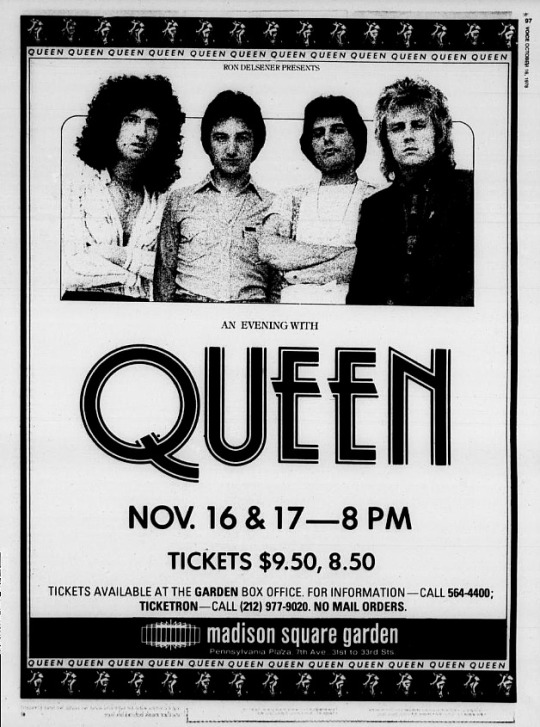

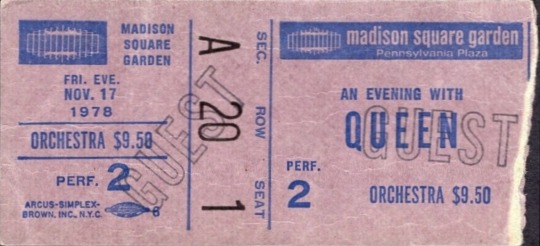










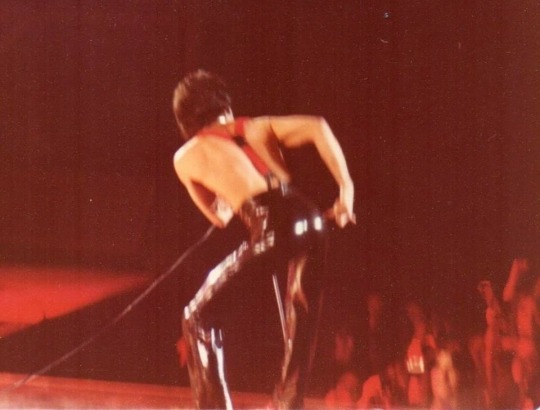

Queen (or at least, some of the members of the band) thought it'd be a great idea to hire a few strippers to ride bicycles on stage topless during Fat Bottomed Girls, as depicted on the sleeve of the 7" single and the Jazz LP mail-order poster. Roger Taylor and a few others were given the (enviable?) task to scout a local strip club to hire some talent for the event. During soundcheck when the band ran the song with the six newly employed ladies, many of the security guards were sure to catch a peek from the balconies. These three New York area shows find Freddie in great voice. But tonight after a couple songs, he is unable to introduce Somebody To Love immediately because the audience is so rowdy. "Listen my darlings, listen to me. I'm talking to you, motherfuckers!" This would probably be the last time he'd address an audience as "darlings." This line reveals him in a stage of metamorphosis between his campy image of Queen's early days to the macho image he was easing into. Brian May introduces the medley thus: "Especially for New York City, we'd like to do a little collage of songs. This is mainly from A Night At The Opera. Do you remember that?" The audience roars in approval. Little do they know (or would they care) that it's the same medley the band have done in every other city, not just theirs. He continues, "It's going to be a pretty rude night, I have to tell you." Freddie snickers at the piano, likely because the audience have no idea what they're in for about an hour from now. Brian snickers as well while he introduces Death On Two Legs. Roger misses a line in I'm In Love With My Car, but the band recover within a couple bars; much better than they do in Glasgow the following year! Freddie gets a bit poignant before a great version of Now I'm Here: "Ok folks, we're gonna do something from the Sheer Heart Attack album. We used to do this song when we were little kids. We've grown up now." And afterward he gets a bit raunchy, "A lot of people call this next song Spread Your Legs. Well, I do too. It's also called Spread Your Wings." As Brian starts playing the acoustic intro to Dreamers Ball, he says it's "a sad little song, this." Freddie dedicates Love Of My Life to "All you Fat Bottomed Girls... and the guys... and the turkeys." Perhaps the turkey comment is referring to the fact that US Thanksgiving is coming up next week. After Love Of My Life, Brian says, "You're a good listening audience. We appreciate that; thank you. That's real nice. Ok, we'd like you to stamp your booties to this number if you feel like it, because you're getting a little fidgety by now. This is an ensemble number. This is called '39." This would be the last show where Roger would play the last two choruses of the song on his scaled-down drum kit on the small stage. From the next concert in Uniondale through the Japanese shows, he'd stick with the tambourine and bass drum for most of the song, switching to the kit only for the last chorus. Having two consecutive choruses with a change from one to the other is definitely the better way to go, so thumbs up to that executive decision. The band then offer a great version of It's Late, with everyone firing on all cylinders. Before Fat Bottomed Girls, Freddie says, "I must say, you're a much better audience than what we had last night. Compared to you, they were dead!" The audience erupts. Near the end of the song, after Freddie shouts "Get on your bikes and ride" (clearly with more excitement than usual), the girls make their grand entrance. Amongst his vocal adlibs is, "You like 'em pretty?" and "You like what you see?" As Roger starts the intro to Keep Yourself Alive, Freddie remarks, "A lovely load of beauties!" The band would create a similar spectacle again next year in Munich. Clearly buzzing off the last song, Brian plays some very nifty lines after the first chorus of Keep Yourself Alive. Between We Will Rock You and We Are The Champions, Freddie proudly dedicates the sport-friendly anthems to the New York Yankees, as they had just won the World Series of baseball for the second straight season. At the end of the show, Freddie hides little by saying, "Sweet dreams, New York. Thank you for your time and your money!" After this show, Queen are presented with a gold ticket, marking 100,000 tickets sold at five shows at the Garden over the past two years. Roger later recalled the Fat Bottomed fun: "We wanted people to think we were having fun and being silly. But there was also a lot of hard work. Trouble is, we got better and better at having a good time.". Pics 1 through 5 are from Nino Trovato, taken by Angela Verdon. Note that the B stage (i.e. with Roger's smaller drum kit) that drops down for the acoustic set can be seen in the pic 4. Pic 5 was snapped while the smaller stage was in its descent prior to Dreamers Ball (the top of John Deacon's head can be seen in the background).
Fan Stories
“Great concert @ Madison Square Garden back in 1978. Bicycle tour whan the semi naked chicks came out on bicycles during Fat Bottomed Girls. Played again the next night at the Nassau Coliseum but no naked chicks. Great memories.” - Bob Kearney
Part-1
34 notes
·
View notes
Text
Albert Oehlen at Gagosian Beverly Hills
March 22, 2021

ALBERT OEHLEN Tramonto Spaventoso
April 22–June 5, 2021 456 North Camden Drive, Beverly Hills __________ Gagosian is pleased to present Tramonto Spaventoso, an exhibition by Albert Oehlen comprising the second part of his version of the Rothko Chapel in Houston as well as other new paintings. The first part of the project—consisting of four paintings that mirror the imposing scale of the Color Field compositions in the Chapel while opposing Rothko’s contemplativeness with their frenetic energy—was exhibited at the Serpentine Galleries, London, in 2019–20. Both parts make up the work Tramonto Spaventoso (2019–20). Oehlen uses abstract, figurative, and collaged elements to disrupt the histories and conventions of modern painting. By adding improvised components, he unearths ever-new possibilities for the genre. While championing self-consciously amateurish “bad” painting, Oehlen continues to infuse expressive gesture with Surrealist attitude, openly disparaging the quest for reliable form and stable meaning.In the large-scale canvases on view at the Beverly Hills gallery, Oehlen employs acrylic, spray paint, charcoal, and patterned fabric to interpret and transform John Graham’s painting Tramonto Spaventoso (Terrifying Sunset, 1940–49), a work by the Russian-born American modernist painter that he discovered in the 1990s and has been fascinated with ever since. Using Graham’s puzzle-like painting as a vehicle for repeated interpretation, Oehlen reconfigures elements in diverse and absurdist ways across multiple compositions. The exhibition, which goes by the same title, is therefore in part an homage to the earlier, lesser-known artist.
Reworking motifs from Graham’s original, including a mermaid and a man sporting a monocle and a Daliesque handlebar moustache, Oehlen improvises on his source. In explosive abstractions in acrylic and spray paint, he combines graphic brushstrokes, deliberate “painterly” drips, surprising color combinations, and textural obfuscations to test the limits of coherence and legibility. Oehlen’s paintings are characteristically disparate, challenging the viewer with unexpected shifts in aesthetic and thematic direction. To accompany Tramonto Spaventoso, Oehlen commissioned music by Steamboat Switzerland, the experimental jazz ensemble with whom he also collaborated at the Serpentine Galleries. Played at intervals throughout the day, the recorded composition draws connections with Oehlen’s own visual strategies. A fully illustrated catalogue, featuring a conversation between the artist and curator Mark Godfrey, will be published on the occasion of the exhibition. Albert Oehlen was born in 1954 in Krefeld, Germany, and currently lives and works in Switzerland. Collections include the Broad, Los Angeles; Museum of Contemporary Art, Los Angeles; Art Institute of Chicago; Museo Jumex, Mexico City; Museum of Contemporary Art North Miami, FL; Cleveland Museum of Art; Museum of Modern Art, New York; Tate, London; Centre Pompidou, Paris; Museum Ludwig, Cologne, Germany; and Museum für Moderne Kunst, Frankfurt am Main, Germany. Exhibitions include Museo di Capodimonte, Naples, Italy (2009); Réalité Abstraite, Musée d’Art moderne de la Ville de Paris (2009); Terpentin, Kunstmuseum Bonn, Germany (2012); Malerei, Museum Moderner Kunst Stiftung Ludwig Wien, Vienna (2013); 55th Biennale di Venezia (2013); Die 5000 Finger von Dr. Ö, Museum Wiesbaden, Germany (2014); Home and Garden, New Museum, New York (2015); An Old Painting in Spirit, Kunsthalle Zürich (2015); Behind the Image, Guggenheim Bilbao, Spain (2017); Woods near Oehle, Cleveland Museum of Art (2017); TRANCE, Aïshti Foundation, Beirut (2018); Cows by the Water, Palazzo Grassi, Venice (2018–19); Unfertig, Lokremise Kunstmuseum St. Gallen, Switzerland (2019), and Serpentine Galleries, London (2019–20). _____ Image: Albert Oehlen in his studio, Ispaster, Spain, 2020. Artwork © Albert Oehlen. Photo: Esther Freund
12 notes
·
View notes
Photo
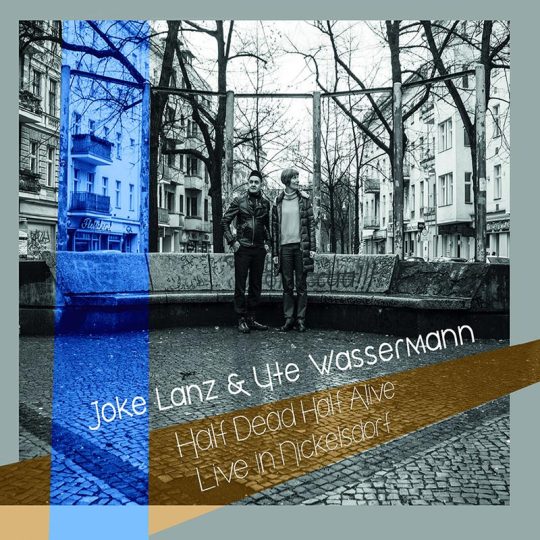



Music reviews by Laurent Fairon, April 2021
Ute Wassermann und Joke Lanz – Half Dead Half Alive (February 2021) Christian Marclay – Graffiti Composition (March 2021) Louis Dufort – Volume (March 2021) Makunouchi Bento – Post-Muzica 34 (April 2021)
. . . . . . . . . . . . .
Ute Wassermann und Joke Lanz – Half Dead Half Alive - Live In Nickelsdorf (Klanggalerie) https://klanggalerie.bandcamp.com/album/half-dead-half-alive-live-in-nickelsdorf
Sound poetry and sound collage duet by German vocalist Ute Wassermann with Swiss turntablist and noise artist Joke Lanz, formerly of Sudden Infant and Schimpfluch groups, recorded live during a performance in Germany in 2019. Ute Wassermann's vocal range is astonishing, from high shrieks to gargling to deep low moans, and she proffers an incredible variety of utterances and noises here, while also complementing her vocals with toy instruments and bird whistles. Joke Lanz plays found vinyl records, special dubplates and sampler—perhaps the bespoke sampling function of a Technics turntable. Some sounds from records are recognizable, like child babble, film music, spoken word, accordion, Japanese shamisen traditional, or even techno, but most of the sampling only plays a fraction of a sound, sometimes reduced to a mere pulp or abstract texture. The duo's music is jumping all over the place in search of new sound combinations, and the album is constantly playful and fun throughout thanks to many unexpected U-turns.
Christian Marclay – Graffiti Composition (Superpang) https://superpang.bandcamp.com/album/christian-marclay-graffiti-composition
This is a new version of Christian Marclay's 1996 Graffiti Composition, a graphic score created from thousands of blank sheet music papers posted in Berlin streets for passers-by to graffiti over. Their anonymous contributions apparently included actual notated music and words as well as any kind of blotches Marclay eventually collected and assembled into a graphic score. Graffiti Composition was premiered in the UK in 2005 by an instrumental ensemble led by Steve Beresford, and then recorded by a New York guitar quintet including Elliott Sharp and Lee Ranaldo in 2006—also available on Bandcamp. This new version is interpreted here by British avant-garde music ensemble Apartment House, and they manage to elevate Graffiti Composition to a gorgeous sound art piece for piano, cello, flute, harp, synthesizer, toy instruments, vocal interjections and noises, all superbly played by ensemble members. While the score itself is a semi-aleatoric assemblage of unconnected abstract parts, it ultimately sounds here like a Fluxus event mixed with classical contemporary music. Apartment House leader Anton Lukoszevieze delivers a great performance on cello, yet he shall also be credited for providing coherence to the original collage work, here delivered as a decent piece of contemporary music in itself, both playful and great fun to listen.
Louis Dufort – Volume (Superpang) https://superpang.bandcamp.com/album/volume
Canadian Louis Dufort, born 1970 in Montréal, is a composer of electronic and electroacoustic music, contemporary instrumental music, as well as compositions combining electronic and acoustic instruments. His music is published by the Empreintes DIGITALes and Pogus labels, among others. Volume is a series of 5 electroacoustic compositions for environmental sound recordings and synthesizer, mingled into dense, homogenous textures with a variety of sound events occuring at all times. Spectacular electroacoustic sound treatments are at work here, with a profusion of radical EQ-ing, algorithmic sound processing effects and stereo positioning, all deliciously ear-tickling, especially on headphones. Unfortunately, both orginal location recordings—rain, stones, stones throwned into water, footsteps—and sound treatments are a tad too traditional and conform to the Empreintes DIGITALes dogma. While the music is cleverly assembled into a coherent whole, the end result is perhaps too polished and lacks diversity and excitement. This is still superb electroacoustic music but more originality and fresh ideas would have been welcomed.
Makunouchi Bento – Post-Muzica 34 (self released) https://makunouchibento.bandcamp.com/album/post-muzica-34
The duo of Felix Petrescu and Valentin Toma from Timișoara, Makunouchi Bento are the first experimental electronic musicians we heard from Romania 20 years ago—before that, us Westerners only knew of the Romanian composers like Iancu Dumitrescu, Ana-Maria Avram or Costin Miereanu. Post-Muzica 34 is a radiophonic sound art piece Makunouchi Bento created for a Romanian radio broadcast in April 2021. It is entirely based on environmental sound recordings from Timișoara, processed and assembled into an aural narrative, a portrait of their hometown. To the unexpected ear, the music might sound entirely electronic, but in fact is largely based on processed field recordings of trains, car engines, car horns, sirens, birds, animals in a zoo, voices, etc. All original sounds being heavily processed, you have to pay attention to recognize some of them. What you can't fail to notice, though, is the great variety of sound effects applied, the weird, fantastic sounds, and the Surrealist atmosphere of the piece, which is also remarkably assembled into a coherent narrative, almost like a hörspiel. My only complain is the lack of stereo use throughout, perhaps because this was an improvised live broadcast and the duo didn't care for stereo then. This petty drawback only adds to the vintage aspect of Post-Muzica 34, which brought to my mind echoes of Luciano Berio and Bruno Maderna's "Ritratto di Città" [Portrait of a City], 1955, and even Walter Ruttman's silent movie "Berlin, Symphony of a Great City", 1927, in regard to the narrative form. An ambitious hörspiel, Post-Muzica 34 has that kind of historical-cum-avantgarde approach.
7 notes
·
View notes
Photo

COLLAGE COMMUNITIES
New York Collage Ensemble
The New York Collage Ensemble was formed by Isabelle Milkoff and Susan Lerner as a way to meet, network and collaborate with other analog collage artists in the New York metro area. The mission of the NY Collage Ensemble is to foster a supportive community to share ideas, collaborative projects, and inspiration revolving around collage. The first collaboration involved creating accordion collage books that were passed from artist to artist. They hold open calls on Instagram and themed collage parties on zoom. The group is currently in the planning stages of creating a workshop, a charity fundraiser, and other collaborative activities. MORE
*****************************
Kolaj Magazine, a full color, print magazine, exists to show how the world of collage is rich, layered, and thick with complexity. By remixing history and culture, collage artists forge new thinking. To understand collage is to reshape one's thinking of art history and redefine the canon of visual culture that informs the present.
SUBSCRIBE | CURRENT ISSUE | GET A COPY
SIGN UP TO GET EMAILS
#collage#collageart#collageartist#art#artist#kolajmagazine#artmagazine#artpublication#artzine#artbook#collagebooks#visualart#contemporary art#contemporary artist#cutandpaste#papercollage#analogcollage#digitalcollage#analog#digital#artshow#artexhibit#artexhibition#artevent#onlineart#artcollecting#artnerd#artistic#handmadecollage#artistspotlight
12 notes
·
View notes
Text
Frantz Loriot — While Whirling (Thin Wrist)

Photo by Philippe Pierre
While Whirling by Frantz Loriot
There’s something very precise about Frantz Loriot’s solo music. What you hear is all there is to hear, which is one person playing a few sounds you expect and many you do not on a viola. It is not programmatic music; there’s no story about Peter and the Wolf or a war between two nations or the emotional anguish that one person suffers when their partner is taken away to fight that war.
Still, it takes place within a series of contexts, beginning with the way it is presented. The physical manifestation of While Whirling is an exactingly produced vinyl record packaged in a striking sleeve that has both glossy and matte finishes. The sleeve looks like a collage, but it is not. It is a mass produced, unified image that is the product of multiple processes, and if you take the sleeve to be a statement made about the music, then you might start wondering what processes resulted in Loriot playing what he played when he played it.
His biography yields some clues. Born of French and Japanese parents and raised in France, he is by training a third-generation classical musician. But even though he participated in many years of classical learning and practice, he never quite cottoned to the family business, and in his 20s, he broke from it. He began playing improvised music, and after a period of seeking education from improvisers, he based himself for a time in New York. Since then, he has performed with musicians from either side of the Atlantic, including Joachim Badenhorst, Pascal Niggenkemper, Jeremiah Cymerman, Duane Pitre and Christoph Erb. More recently, Loriot received his mail in Zurich, Switzerland, where this LP was recorded.
What Loriot has played with other musicians has often related in some way to classical practice. For examply, Baloni, his trio with Badenhorst and Niggenkemper, sounded like a chamber ensemble, albeit one that drew heavily upon the vocabulary of improvised music. But his solo music’s relationship to the classical tradition is one of refutation. The lot of most classical musicians is not that different from that of highly skilled factory workers; they learn to do what others tell them to do, and their work depends upon their ability to satisfactorily make something that has been determined by designers and institutional decision-makers. In an interview on the Thin Wrist website, Loriot describes his alienation from the music, its social-political structures. He chose not to play that game, and every time he plays a sound that would earn opprobrium in that context, he’s refuting it anew.
But that doesn’t mean that While Whirling is just an expression of rebellion. It is a concentration of acts of making, for what is improvised music, but an enactment of making and finishing something for a present or anticipated audience? It is also a modeling of fluid, evolving relationships that deal with questions as well as known quantities. What’s this sound worth? What can this instrument really do? How does one combine conventional and unconventional sounds, and why should anyone care? The constants in Loriot’s music are his use of the viola, and the tension he generates with it. Whether it’s a brute rasp, a barely-there whisper, or an isolated pluck and its consequent reverberations, he makes sounds that demand to be heard. This music isn’t about remembering events past, or soothing some part of your mind while you do your daily tasks; it’s about making the most of a moment, delivering a charge to a space you entered and a moment that began when you sat in your seat or put the tone arm on the record, one that will end when you walk out of the room, or when the needle either picks up or doesn’t (one side ends in a locked groove). It’s about Loriot’s presence in a present, which in turns influences your present. It’s real, right now. Consider it a gift.
Bill Meyer
#frantz loriot#while whirling#thin wrist#bill meyer#albumreview#dusted magazine#solo improvisation#viola
2 notes
·
View notes
Photo

Femme en chemise dans un fauteuil ART INSTITUTE OF CHICAGO/RMN-GRAND PALAIS/IMAGE OF THE MMA-SUCCESSION PICASSO 2020 Picasso, le bonheur esthétique avec Eva
par Philippe Dagen , Le Monde
Publié le 27 août 2020 SÉRIE« Mes œuvres-cultes » (4/6). Notre collaborateur Philippe Dagen, critique d’art, revient sur six créations qui l’ont marqué. Aujourd’hui, « Femme en chemise dans un fauteuil », du maître cubiste. Celle-ci, impossible de savoir quand je l’ai vue pour la première fois. Peut-être photographiée dans le catalogue de la rétrospective Picasso au Museum of Modern Art de New York (MoMA) en 1980, et c’était alors en noir et blanc – les catalogues n’étaient pas encore imprimés tout entier en couleur. A cette date, l’œuvre appartenait à la collection Ganz, à New York, dispersée depuis. Elle a été montrée en 1989 au MoMA de nouveau, mais, à l’inverse d’autres Picasso, elle a peu voyagé. Quelle œuvre ? “Femme en chemise dans un fauteuil”, de l’automne 1913, huile sur toile de dimension moyenne. Les couleurs sont sourdes, les plus intenses étant des nuances de ce que l’on appelle « vieux rose » dans le vocabulaire de la décoration. La femme en chemise est Eva Gouel, l’amie de l’artiste. La toile est une déclaration d’amour. A une date incertaine, Picasso et Fernande Olivier, sa compagne depuis 1905, rencontrent dans une brasserie du boulevard de Rochechouart, à Paris, le peintre Louis Marcoussis et Eva Gouel, qui se fait alors appeler Marcelle Humbert et vit avec lui depuis 1907. Dès lors, les deux couples se rencontrent assez souvent et semblent s’être rendus ensemble chez Gertrude Stein rue de Fleurus. Ils se voient tant qu’à l’automne 1911 Eva et Picasso sont bien plus que des amis. Le peintre, qui est installé depuis l’automne 1909 dans un atelier boulevard de Clichy, reloue alors un atelier à la cité d’artistes du Bateau-Lavoir pour y recevoir Eva secrètement. Secret mal protégé : Gertrude Stein se doute vite que la mention « ma jolie » inscrite dans une nature morte, La Table de l’architecte, ne fait pas allusion à Fernande. Laquelle résout la question brutalement : elle quitte Montmartre au printemps 1912 avec le peintre italien Ubaldo Oppi, qui est alors futuriste. Dès lors, rien ne retient plus Eva et Picasso de partir ensemble dans le Sud, à Céret (Pyrénées-Orientales) d’abord, à Sorgues (Vaucluse) ensuite, puis, de retour à Paris, de changer de rive et de quartier : Montparnasse, boulevard Raspail et, à l’automne 1913, rue Schoelcher. « Marcelle est très gentille et je l’aime beaucoup et je l’écrirai dans mes tableaux », a annoncé Picasso à son marchand Daniel-Henry Kahnweiler, le 12 juin 1912. Dans “Femme en chemise dans un fauteuil”, il ne l’écrit pas, il donne à voir en la peignant – en la peignant selon la manière qui est alors la sienne et qu’elle l’a vu inventer chaque jour. A la fin de 1913, il y a en effet à peu près un an que Picasso et Braque expérimentent ce que l’on nomme « papiers collés », des œuvres dans lesquelles objets et lieux ne sont plus représentés de manière plus ou moins réaliste par la peinture, mais indiqués par plusieurs moyens qui se complètent dans l’esprit du regardeur. Le plus immédiat est le dessin au fusain sur le papier. Il peut être imitatif – la crosse en spirale d’un violon – ou géométrisé et déformé – un trapèze de guingois pour un verre, un triangle pour un nez. Des découpages prélevés dans les journaux et dans les papiers de décoration qui imitent l’aspect du bois ou du marbre affirment sur le fond blanc le profil d’une bouteille ou la matière dans laquelle est construit le violon – le bois – ou la table de bistrot – le marbre. Les fragments imprimés sont aussi à lire pour ce qu’ils annoncent – une actualité, une publicité, le programme d’un cinéma, le titre d’une chanson comme cette Ma jolie, de Fragson. Equation visuelle Il est encore possible d’introduire des mots ou des parties de mots manuscrits, « JOU » pour journal, « Bass » pour la bière, « Bach » pour la musique. Ces différents modes de désignation des êtres et des choses, qui resteraient elliptiques pris séparément, se comprennent quand ils sont associés : l’œuvre fonctionne comme une équation visuelle à résoudre par une suite de déductions. Elles permettent de reconstruire la guitare sur son guéridon, l’homme au chapeau ou tout autre motif. Il ne s’agit pas, comme on le lit encore parfois, de montrer les choses sous différents angles, mais de les suggérer selon différents moyens mentaux autant que visuels. A partir de l’hiver 1912-1913, les deux artistes développent cette méthode absolument nouvelle, à laquelle la plupart de leurs contemporains demeurent étrangers, à l’exception de deux poètes, Guillaume Apollinaire et Max Jacob. “Femme en chemise dans un fauteuil” est l’extension de cette méthode d’« analyse-synthèse » – la formule est d’Apollinaire – à la toile. Aux vrais collages sur papier succèdent des imitations de collages peints, mais l’idée de suggérer les formes par l’allusion, l’abréviation et la métonymie demeure intacte. Donc, si on commence par le plus simple, le fauteuil est en plusieurs morceaux, tantôt une surface brun sombre qui indique le dossier, des parties des accoudoirs traitées en trompe-l’œil délibérément imparfait et les franges à torsades en deux sections. Il s’agit donc d’un beau fauteuil bourgeois, à haut dossier, capitonné, vraisemblablement en velours, de style Second Empire. Pour Eva, c’est moins simple. Pour la recomposer, il est possible de commencer par sa chemise ou par son visage. La chemise froissée aux reflets gris argenté est au centre de la toile. Dès qu’elle est repérée, le nombril l’est aussi : deux petits cercles concentriques. Du nombril, le regard remonte au torse et aux seins longs et pointus, ce que l’on appelle souvent dans la littérature de gare des seins en obus. Si l’œil s’est d’abord fixé sur le triangle presque du même rose que le fauteuil, la ligne blanche verticale qui marque le nez et les deux petits points blancs des yeux suffisent pour marquer l’emplacement du visage. Les ondulations à diverses nuances de brun et d’ocre figurent la chevelure. Elle descend en courbes le long d’un triangle très aigu, qui apparaît comme le cou sur lequel le visage triangulaire est fiché. A la base de ce triangle, il y a deux hémisphères au centre desquels deux cônes sont plantés, on dirait deux fruits – des pommes ou des pêches – qui auraient conservé un bout de queue. Pourquoi ces fruits ? Parce que c’est une banalité que celle qui compare les seins des femmes à des fruits, habitude qu’Apollinaire parodie parfois. Une fois ces éléments identifiés, les autres se mettent en place d’eux-mêmes : la main qui tient le journal, les cuisses de part et d’autre de la chemise, les genoux ronds et jusqu’aux pieds. Inséparable de ses expérimentations La genèse de l’œuvre est passée par des études au crayon et à l’aquarelle. Dans l’une d’elles, il y a une fenêtre ouverte, un ciel traversé de nuages et des fanions, détails que Picasso a supprimés. Dans une autre, le visage est un parallélogramme marqué des signes du nez, des sourcils et de la bouche. Picasso est allé vers une simplification plus épurée encore. Aussi n’a-t-il rien repris de la physionomie de sa compagne, bien qu’il dessine d’elle au même moment un portrait, au sens où ce mot s’entend d’ordinaire, un portrait ressemblant, presque classique. Alors pourquoi Eva dans cet état ? Sans doute d’abord parce qu’elle est, pour Picasso, inséparable de ses expérimentations artistiques, qu’elle suit et comprend bien mieux qu’avant elle Fernande Olivier, que l’art finissait par ennuyer. Plus tard, Picasso associe de même Marie-Thérèse Walter et Dora Maar à des manières spécifiques de dessiner et de peindre, qui sont, si l’on peut dire, leurs manières particulières. Pour Eva, c’est cet état du cubisme, qui n’a plus rien de commun avec ce qu’il était en 1908 ou 1909. Tout est désormais permis, les fragmentations à recomposer, les abréviations à compléter mentalement, les couleurs aussi incongrues que ce vieux rose qui fait irruption dans un monde jusqu’alors à peine coloré de bistres, gris et ocres. Picasso joue avec Eva, qui connaît les règles de ce jeu. Picasso célèbre moins la grâce de la jeune femme – tout en doublant sa poitrine – que leur parfaite entente amoureuse et artistique. Leur bonheur est inscrit dans cette toile et, plus d’un siècle après, il demeure sensible. Lire aussi : A Royan, Pablo Picasso se met au vert Lire aussi : Entre Eluard et son « frère » Picasso, une amitié profonde Lire aussi : Confrontation de baigneuses, à Lyon
#Pablo Picasso#Eva Gouel#Femme en chemise dans un fauteuil#Georges Braque#Guillaume Apollinaire#Max Jacob#Cubisme
5 notes
·
View notes
Photo

Obamas, Dior, and Warhol coming soon to the Brooklyn Museum! Join by Sunday, June 6 to access our Member pre-sale taking place June 10–16, before tickets are released to the public. To sweeten the deal, we invite you to become a Member at a special discounted price!
The Obama Portraits Tour Opening August 27 The Obama portraits make their Brooklyn debut this summer, featuring Kehinde Wiley’s portrait of President Barack Obama and Amy Sherald’s portrait of Michelle Obama.
Christian Dior: Designer of Dreams Opening September 10 The NY premiere of Christian Dior: Designer of Dreams traces the groundbreaking history and legacy of the House of Dior and features unique pieces drawn from Dior's archives—including 200+ haute couture garments. Opening September 10.
Andy Warhol: Revelation Opening November 19 Experience Andy Warhol: Revelation, the first exhibition to examine the Pop artist's complex Catholic faith in relation to his century-defining artistic practice.
Images: Kehinde Wiley (American, born 1977). Barack Obama, 2018. Oil on canvas. National Portrait Gallery, Smithsonian Institution. © 2018 Kehinde Wiley; Amy Sherald (American, born 1973). Michelle LaVaugn Robinson Obama, 2018. Oil on linen. National Portrait Gallery, Smithsonian Institution. The National Portrait Gallery is grateful to the generous donors who made these commissions of the Obama Portraits possible and proudly recognizes them at npg.si.edu/obamaportraitstour. Support for the national tour has been generously provided by Bank of America; Christian Dior (French, 1905-1957). Bar suit, afternoon ensemble with an ecru natural shantung jacket and black pleated wool crepe skirt. Haute Couture Spring–Summer 1947, Corolle line. Dior Héritage collection, Paris. (Composite scan: Katerina Jebb); Andy Warhol (American, 1928–1987). The Last Supper (Detail), 1986. Screenprint and colored graphic art paper collage on HMP paper. The Andy Warhol Museum, Pittsburgh; Founding Collection, Contribution The Andy Warhol Foundation for the Visual Arts, Inc., 1998.1.2125. © 2021 The Andy Warhol Foundation for the Visual Arts, Inc. / Licensed by Artists Rights Society (ARS), New York. Used with permission of Warhol Foundation
#ObamaPortraitsTour#christian dior#dior#obama#andy warhol#warhol#warholrevelation#brooklyn museum#bkmmembers#brooklyn#museum#art#fashion#portrait#warholfoundation
34 notes
·
View notes
Photo
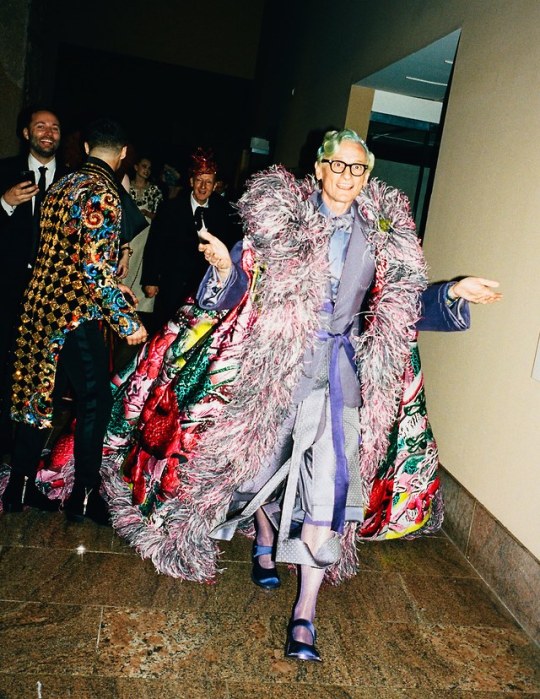
The Story Behind Hamish Bowles’s Maison Margiela Artisanal by John Galliano Met Gala Look
By Hamish Bowles, published by Vogue on 08 May 2019. Photography by Mehdi Lacoste.
John Galliano was always a star. When I started on my Foundation course in the early 1980s at Saint Martin’s School of Art, as it was then known, he was already a supernova of the fashion department, his exquisite drawings setting him on a sure path to becoming an illustrator. He inspired me to decide on a career in fashion rather than costume design (I had been torn), and after the Foundation course, I stayed on at Saint Martin’s to pursue just that. As John worked on his degree collection the following year, he holed up in the college library, hidden behind stacks of reference books that served a double purpose: They defined his private work space and helped to shield his jealously guarded sketches from prying eyes. As it turned out, John had taken inspiration from the Incroyables—the male and female dandies who emerged in the wake of the French Revolution with their own exaggerated versions of revolutionary style. He even burnt the edges of his drawings and dripped candle wax over them to create the illusion that they had been salvaged from an aristocrat’s ransacked mansion.
The collection was sensational—Joan Burstein, who ran Browns, London’s most fashionable boutique, bought it in its entirety. John couldn’t afford a taxi to transport it, so he wheeled it on a dress rail all the way to South Molton Street, where Mrs. B put it in her window and Barbra Streisand and Diana Ross bought pieces right out of it: They were his very first clients. John turned down a job offer to become an illustrator in New York and instead set up his eponymous brand there and then on a wing and a prayer.
I wore pieces from that first collection—waistcoats made from patches of 18th-century-style upholstery silks and sprigged cottons, jersey long johns, and vast organza shirts tying at the throat with a huge jabot. (John has re-created one of these looks to complete an ensemble built around a coat from this collection that the Metropolitan Museum of Art’s costume department has recently acquired and that is showcased in Andrew Bolton’s brilliant “Camp: Notes on Fashion” exhibition.)
The following season, John didn’t have the money to stage a fashion show, so he did a presentation instead in an old artist’s studio off the King’s Road. This collection was based on a 1920s cartoon in the satirical British weekly Punch titled Afghanistan Repudiates Western Ideals, and it explored a collision of Occidental and Afghan dress in John’s characteristically intriguing way. One of my ensembles from this collection—including a knee-length skirt that caused a sensation in Paris when I wore it to the collections that season—is now in the Boston Museum of Fine Art’s exhibition “Gender Bending Fashion.”
As soon as I heard the theme of this year’s Costume Institute show, I thought it would be the perfect moment to work again with John, who has found expression for his unquenchable creative force once more at the Maison Margiela. John had already made me a bias-cut black satin evening suit that evoked Shalom Harlow’s look from his unforgettable Fall 1994 show in Paris socialite Sao Schlumberger’s empty Louis Seize mansion.
To my great delight, John was soon on board. I sent some inspiration images of my eclectic pantheon of camp icons, including Mrs. Slocombe, the character with the Elnett-hairspray-bottle hair in ever-changing pastel hues, from the British sitcom Are You Being Served?; Quentin Crisp; Barbara Cartland; and Jazz Age aesthete Stephen Tennant. Together with John’s partner, Alexis Roche, we looked at looks from the Martin Margiela Artisanal Men’s Spring 2019 collection and isolated some silhouettes that we thought could work for me.
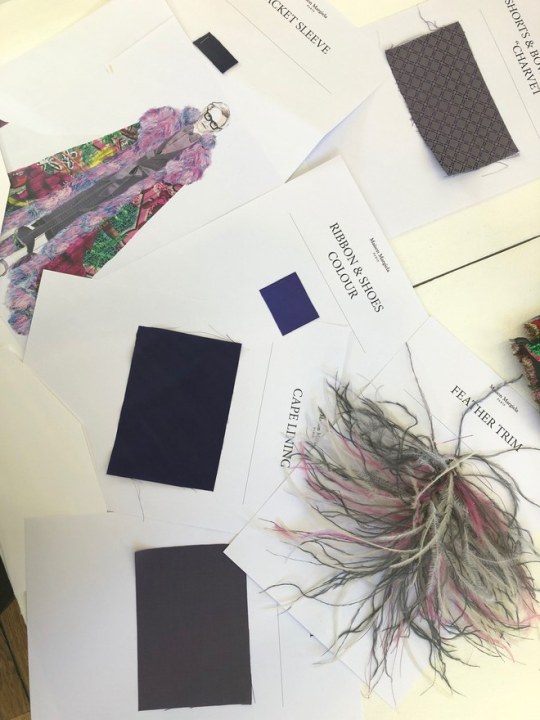
Source: Maison Margiela
At Saint Martin’s, John and I shared an inspirational mutual friend in the indubitably camp form of David Harrison, who was studying in the Fine Art department, had once improbably been scouted to front a punk band to be called the Sex Pistols (Johnny Rotten got the gig), and worked a Teddy Boy look that he accessorized with white winklepicker shoes, a peroxide quiff, and a pom-pom clipped white poodle dyed shocking pink who often appeared in his artworks. John’s studio had produced a frenetic collage print that was worked not only into the clothes but the runway itself, and that incorporated an Yves Klein blue poodle in everything from jacquard to tufted embroidery. I wondered if the poodle couldn’t go pink in homage to our camp friend?
Meanwhile, John’s studio sourced a jacquard cravat in mauve from Charvet, the storied Parisian men’s outfitter, and a selection of textiles in shades of grape and wisteria. (Charvet also made the shirt, and I found some Pepto-Bismol pink cufflinks in my own closet that the sculptor Andrew Logan had made for the John Waters high-camp superstar Divine in 1987. These would be my talismans for the night.)
When I went to Paris for my first fitting, after an initial visit to take measurements, John wasn’t in town, but Raffaele Ilardo, Margiela’s inspired head fitter, and his associate Jung A. Park were there to attend to all the finer points. There was already an amazing sample of the jacquard with the electric-pink poodles, and of the ostrich trim that John had instructed be embellished with metallic lurex threads to catch the light on the red (pink) carpet. (“Invisible to the naked eye but will pop in pictures, trust me,” he said.) Ilardo apprenticed with the legendary tailor Paquito (who carved Karl Lagerfeld’s most amazing suits at Chanel Haute Couture in the ’80s and ’90s), and he had made the most beautiful toiles, with a jacket that sat perfectly on my shoulders without adjustment and had a beautifully constructed rising roll at the top of the sleeves. The cape was constructed like a Victorian visite, with openings for the arms and subtle shaping in back. It was so perfectly constructed that I could have worn the toile itself.
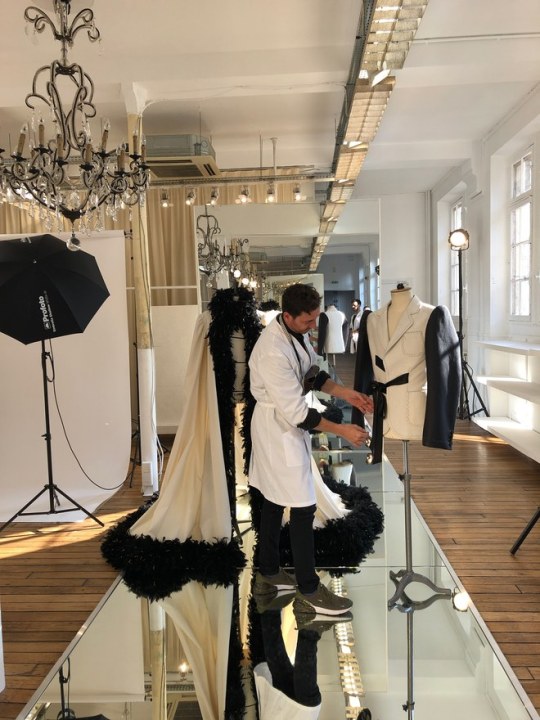
Raffaele Ilardo working on the toile. Photographed by Alexis Roche.
“I advise that cape is rehearsed up and down steps if you can,” said John after he reviewed the fittings videos from afar. “No angle must be left to chance but still must look spontaneous. Every swish must be ingrained in the subconscious, and always imagine that Avedon is following you. A sudden knock at the door works wonders for that frozen-eyes-to-the-left look. Never forget Avedon is your focal point.”
A little over two weeks later, with the clock ticking before the Gala, I returned to Paris for a final fitting with John in the house. To my amazement, the entire ensemble had now been made, including the wide-toed Mary Jane shoes, shown in patent but specially remade for me in violet satin. There were two options of subtly different lilac, for a sheer sock dotted with a point d’esprit effect that was faintly obfuscated by the crushed hairs on my legs and would definitely be showcased, as the short pants hovered only a little below the knee. John gave my lower calves a long, hard look. “You’ll wax them just before the gala,” he instructed firmly. (“Always better when viewed through sheer, tons of moisturizer 15 mins before socks are put on,” he advised nearer the day.)
“It’s unbelievable,” I said when I saw the cape arranged on a tailor’s dummy in John’s light-flooded Margiela atelier. “It’ll only become unbelievable when you start to wear it,” said John. And, sure enough, when I put on the cloak and began walking up and down the studio and it caught the air in its massy volumes, it lifted up like a cloud, and, despite the thick feather fronding, seemed almost as light as one. “La légèreté!” John proclaimed exultantly, “It looks like a canvas, like you’re coming out of a painting.” I used the Margiela staircase to rehearse maneuvering the cape up and down the pink carpet, and I tried to work it from every angle, thinking by turns of Dietrich and Dovima and Proust’s beloved Comtesse Greffulhe. (“I love that little coyness!” said John. “It’s a Dorian Gray moment!”)
I’d asked John’s longtime collaborator and my great friend Stephen Jones for thoughts on something for the head (he concocted the custom top knots for the “Camp” exhibition mannequins) and he designed a wonderful tiara bandeau made of Swarovski crystals that were custom-produced in the required lilac hue and, like those lurex fronds, would add some pink carpet dazzle. John pronounced it a “very cool touch” and suggested “surfer pink” hair to match.”
On the eve of the gala, I submitted to leg waxing and sundry other beautifications (“Lymphatic drainage on face the night before always refines,” John had counseled, and thank you, Tracie Martyn, skin alchemist). On the morn, I went to the Greenwich Hotel to be ministered to by the brilliant Teddy Charles and his assistant Satoshi Ikeda, alongside Amber Valletta, and then I hied up to the St. Regis in a white Maserati to meet John, Alexis, and Raffaele and practice some more swishing and strutting in the hotel’s ballroom under their watchful eyes. “The Japanese kids are going to go mental for it,” said John of my Savile Row meets School Boy meets Comtesse de Castiglione lewk. Stephen fitted the tiara, which perfectly framed those Teddy-tweaked waves.
“Command your space!” said John as I headed out, “Hamish, it will be a riot!” How right he was.

Hamish Bowles at a fitting for his first custom Margiela look in 2018, photographed by Alexis Roche.
Source: Vogue.com
#Maison Margiela#Margiela#Hamish Bowles#Maison Margiela by John Galliano#John Galliano#Galliano#fashion#Vogue#Met Gala#Met Gala 2019#Met Ball#Met Ball 2019#Camp: Notes on Fashion#atelier#behind the scenes
43 notes
·
View notes
Text
29/10/19 : TEDDY BOYS. HAUL GIRLS. #1
What are they?
Teddy Boy: (in the 1950s) a young man of a subculture characterised by a style of dress based on Edwardian fashion (typically with drainpipe trousers, bootlace tie, and hair slicked up in a quiff) and a liking for rock-and-roll music.
Haul Girl: A girl or women who makes a haul video.
The revolution will not be televised.
youtube
The tv shows you what it wants to show you.
Television tells us what the people who run the TV stations want us to know. But social media today sometimes provides an alternative.
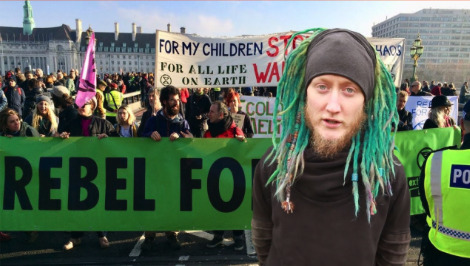


Subculture - Under/Beneath
We are looking today at youth and subcultures… their historicity and their contexts, and where we are with what might be called subcultures and youth cultures today.
GUIDE TO THE CULTS
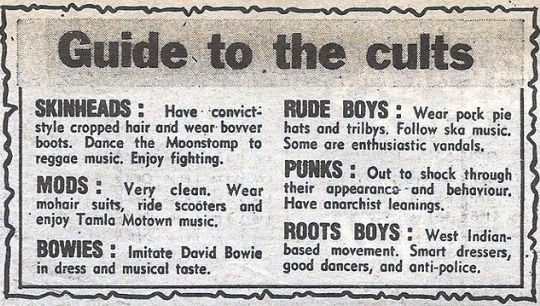
A genuine piece from the mirror in the 1980s.
youtube
Sex Pistols : This is one of the most infamous moments on television. Today it seems tame, but in 1976 this was enough to get the presenter fired.
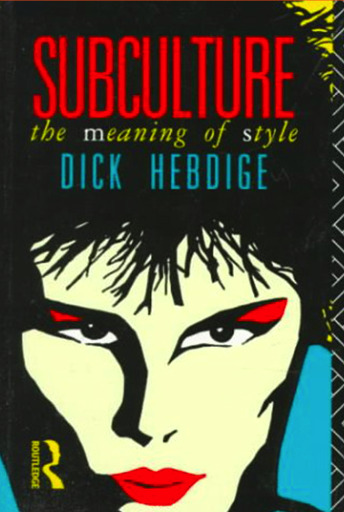
Like Duchamp's 'ready mades' - manufactured objects which qualified as art because he chose to call them such, the most unremarkable and inappropriate items - a pin, a plastic clothes peg, a television component, a razor blade, a tampon - could be brought within the province of punk (un)fashion...
Dick Hebdige - Subculture: The Meaning of Style
Hebdige’s book has long been consider the authorative text on subculture.
In the book he discusses the ready made aesthetics of punk. Punk was the first reaction to the developing politics of Thatcher and Reagan… here a refusal to take part in business as normal led to music that sounded amateur and fresh… the opposite of the progressive rock that had dominated the mid 1970s and early 80′s.
Vivienne Westwood
Objects borrowed from the most sordid of contexts found a place in punks' ensembles; lavatory chains were draped in graceful arcs across chests in plastic bin liners. Safety pins were taken out of their domestic 'utility' context and worn as gruesome ornaments through the cheek, ear or lip...fragments of school uniform (white bri-nylon shirts, school ties) were symbolically defiled (the shirts covered in graffiti, or fake blood; the ties left undone) and juxtaposed against leather drains or shocking pink mohair tops.
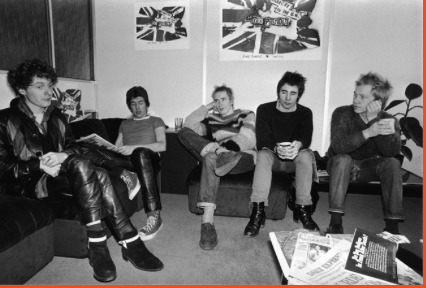

Jamie Red and others made zines that could be assembled in this same way, collaging and making work that felt it could have been made in the house, and often was.
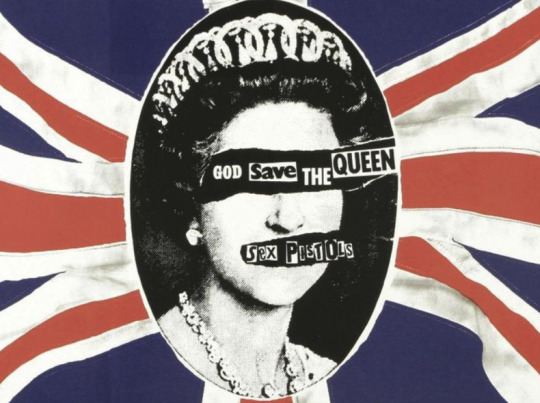
Subcultures
Subcultures are tribal, bringing people together to form loose relations outside of the mainstream.
Different subcultures:
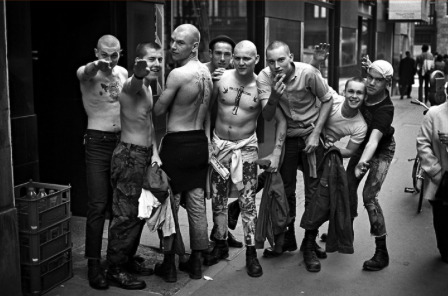
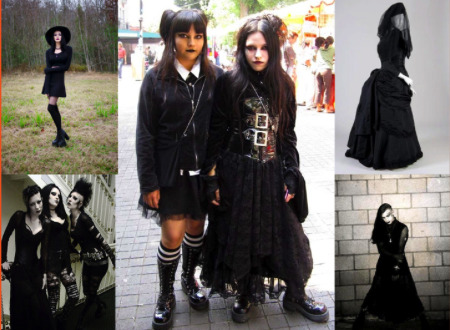
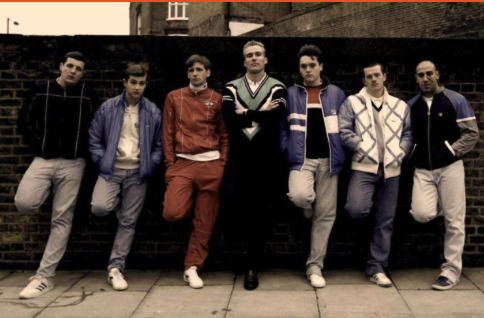
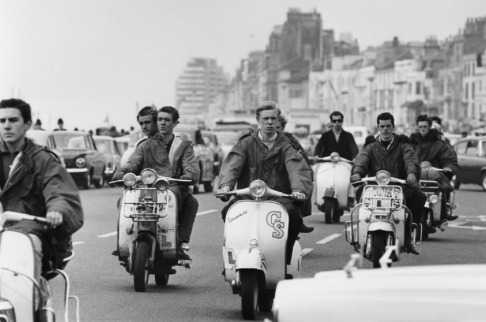
Even subcultures have subcultures… specific types of goth (steampunk, lolita) rude boys, K Pop sub genres, grunge punk rock etc
Once about a specific youth culture movement based around the disco music of the 1970s, clubbing subculture developed into rave culture in the late 80s and 90s, and has become a mainstream movement in the last few years.

Fiorucci Made Me Hardcore, Mark Leckey, 1999
youtube
“Something as trite and throwaway and exploitative as a jeans manufacturer can be taken by a group of people and made into something totemic, and powerful, and life-affirming.”
Subcultures are about a sense of belonging, often to people who feel excluded or disenfranchised from the mainstream.
youtube
Cosplay - form of subculture
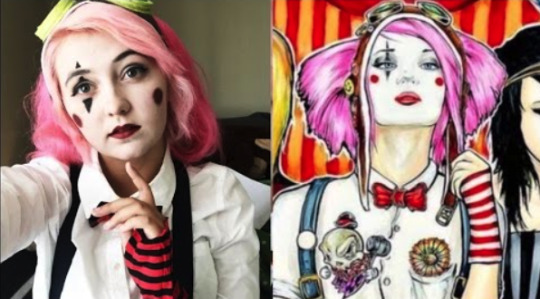
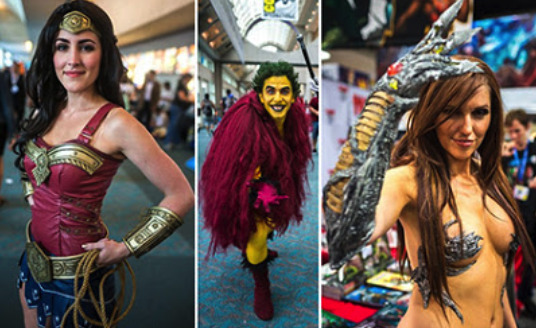
The Joker and Harlequin are both characters who live for misrule, and both of them come from characters in the commedia dell’arte.
Harlequin relates directly to Harley Quinn… the Lord of Misrule was the peasant who was given the task of making sure that Xmas revellers got very drunk and very naughty.
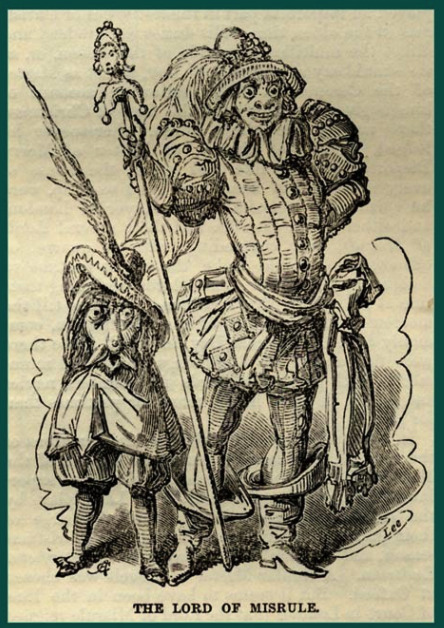
The World Turned Upside Down
These characters link back to the ideas of the carnival, a time when the world was turned upside down. Christmas was initialy this kind of festival. People didn’t know if they would make it through the winter, so they made merry whilst they could. In the carnival Kings become Jokers, Jokers became kings.
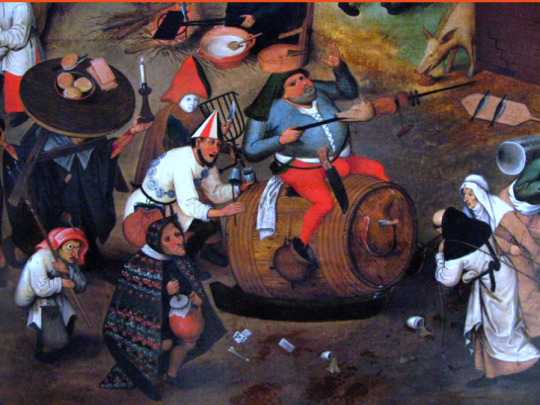
Carnival extracts all individuals from non-carnival life, non-carnival states and because there are no hierarchical positions during carnival, ideologies which manifest the mind of individuals cannot exist.

...And finally in a few relatively rare instances, we find an extreme form of revelry in which the participants play-act at being precisely the opposite of what they really are; men act as women, women as men, kings as beggars, servants as masters, acolytes as bishops. In such situations of true orgy, normal life is played in all manners of sins such as incest, adultery, transvestitism, sacri- lege, and lese-majeste treated as the order of the day...
Edmund R. Leach, Rethinking Anthropology
In Rabelais and His World (1965), Mikhail Bakhtin likens the carnivalesque to the type of activity that often takes place in the carnivals of popular culture. In the carnival, according to Bakhtin, social hierarchies of everyday life—their etiquettes, and normal structures—are turned on their head.
Court jesters become kings, kings become beggars; opposites are mingled (fact and fantasy, heaven and hell).
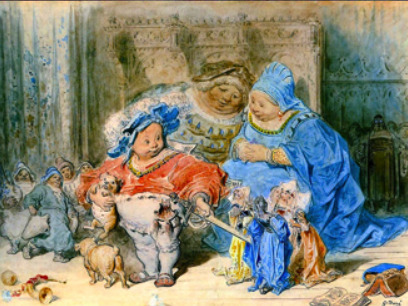
Drag Cultures

Much in the same way that Madonna, undeniable icon though she is, in no way invented voguing, neither did the queens on RuPaul’s Drag Race invent the concept of "shade", "realness" or any of the other essential sayings liberally adopted wholesale by the internet. But what the show has done is continually provide a potted queer history. Whether it’s through highlighting ball culture, trans activism, gender fluidity, or queens like the legendary Lady Bunny; or simply by allowing the contestants to talk about their lived experience, the show has put an all too rare slice of gay and trans history in American (and the world’s) living rooms and laptops.
Drag Race has brought a subculture into the mainstream. It has brought secret languages into modern parlay.
From RuPaul raising a pair of opera glasses to say archly, “I can’t wait to see how this pans out”, to season four queen Latrice Royale’s “the shaaaaade of it all”, social media’s gif game has been vastly bolstered by nine seasons of this show. A gif reaction needs to encapsulate maximum emotion, drama, and appearance – and the queens on Drag Race have all three in spades. Tumblr couldn’t create gifs fast enough in the early seasons, and the joy of so many strong characters, and sound-bites, means that there is a reaction for absolutely every occasion. Season 6 winner Bianca Del Rio named one of her world tours after her own much-gif’d catchphrase, “Not today Satan”.
Memes and online culture have helped the show become part of the everyday.
Historically, "sissy" has been used as an insult against feminine-seeming men. Ru-Paul’s Drag Race not only reclaims the word – “now sissy that walk” is the phrase said at the top of each catwalk, usually preceding a demonstration of almost gob-smacking creativity – but shows that adopting a truly feminine character requires massive amounts of charisma and self-confidence. The show is wildly popular with women, not simply because of the incredible looks and transformations served by each queen, but because it is a celebration of feminine mystique in all its forms.
It has helped reclaim a sense of agency in an era of toxic masculinity.
The little show that could has turned into a global behemoth, with tours around the world each year, and an annual convention in Los Angeles. Last year, a second US convention launched in New York, while London hosted the first European edition, DragWorld UK, which saw a number of the show’s queens and RuPaul’s right-hand judge, Michelle Visage, holding court. And as fabulous, glamorous and downright funny as the queens are, the real joy came from seeing the response of teenagers to meeting their idols. RuPaul and Visage are giving hope to lost kids around the world, whatever their gender, ethnic background or sexuality. By sharing their stories, the Drag Race contestants are giving comfort and inspiration to viewers, as well as swathes of entertainment.
The show has brought disenfranchised, often hidden cultures into the open. And given people something that not only entertains, but also empowers.
The difference between Drag Race US and Drag Race UK summed up in one perfect tweet…
With RuPaul’s Drag Race UK finally airing on both sides of the Atlantic Ocean, it’s got fans realising just how different the two editions of the show are… International fans were subjected to the colourful world of British slang and swear words, leaving dozens bemused about what exactly the UK queens are actually saying…. But in a viral tweet shared by one of the British queens, it’s managed to capture the crucial difference between the US and UK versions of Drag Race.
Sum Ting Wong shared a screenshot of a Facebook post that so beautifully sums up the two shows:
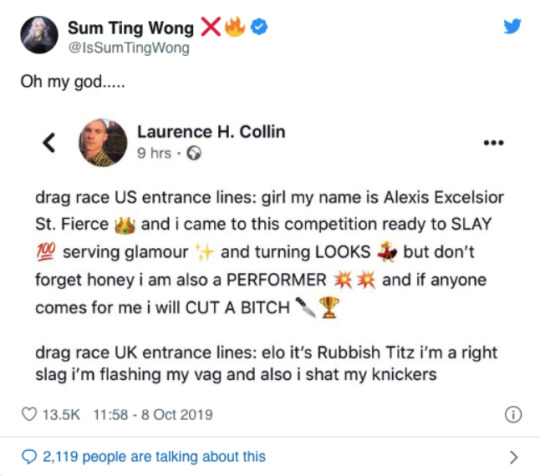
Pink News JOSH MILTON OCTOBER 8, 2019
Drag is culturally derived, and finds its forms based on local customs. In the UK drag has a relationship to Vaudeville and play, which means it does something different to the american show. It is less about the act of putting on a show, and more about the comedic, slightly catty relations that we have come to associate with saturday evening tv here in the UK.
But that doesn’t mean it is mean in itself… it still brings a subculture to a mainstream audience. Remember, if I talked about this with you in the 1990s, I would face prosecution under Section 28
"shall not intentionally promote homosexuality or publish material with the intention of promoting homosexuality" or "promote the teaching in any maintained school of the acceptability of homosexuality as a pretended family relationship".
New Subcultures

‘It's hard not to be struck by the sensation that, emos and metalheads aside, what you might call the 20th-century idea of a youth subculture is now just outmoded. The internet doesn't spawn mass movements, bonded together by a shared taste in music, fashion and ownership of subcultural capital: it spawns brief, microcosmic ones.
In fact, the closest thing to the old model of a subculture I've come across is Helena and the haul girls. Their videos are about conspicuous consumption: a public display of their good taste, carefully assembled with precise attention to detail. When you put it like that they sound remarkably like mods.’
Alexis Petridis
Marie Antoinette, 2006 (Sofia Copolla)
youtube
3 notes
·
View notes